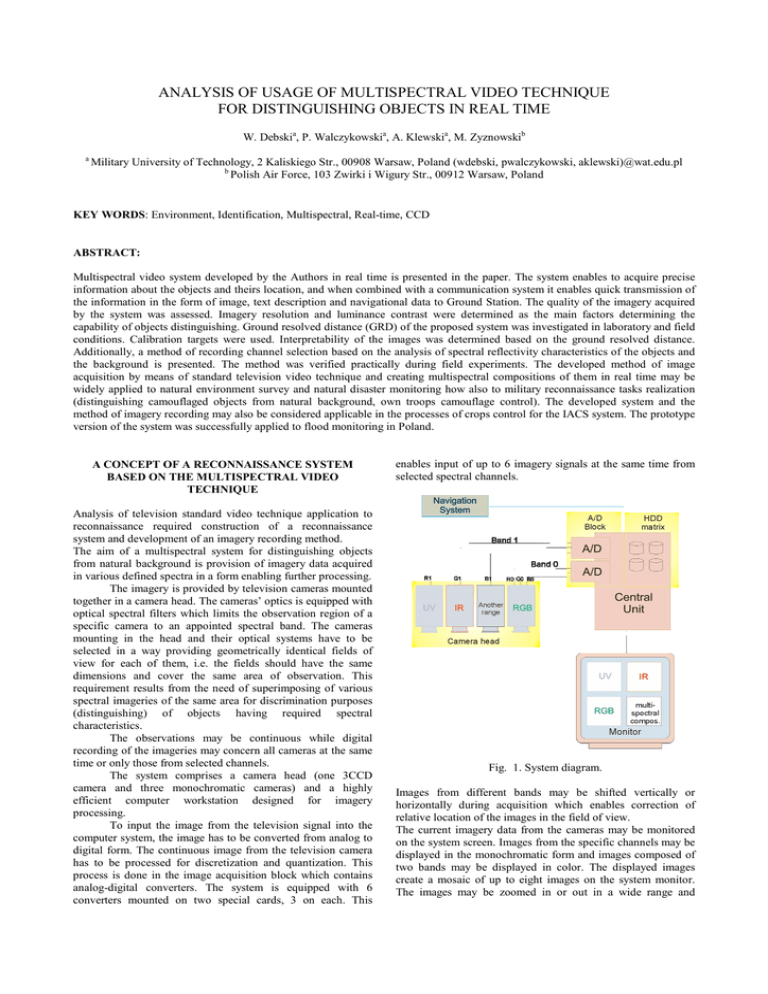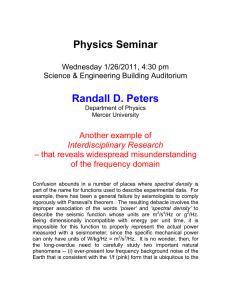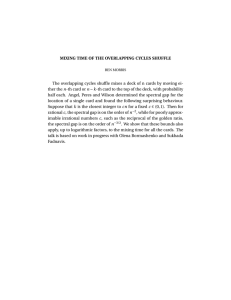ANALYSIS OF USAGE OF MULTISPECTRAL VIDEO TECHNIQUE
advertisement

ANALYSIS OF USAGE OF MULTISPECTRAL VIDEO TECHNIQUE FOR DISTINGUISHING OBJECTS IN REAL TIME W. Debskia, P. Walczykowskia, A. Klewskia, M. Zyznowskib a Military University of Technology, 2 Kaliskiego Str., 00908 Warsaw, Poland (wdebski, pwalczykowski, aklewski)@wat.edu.pl b Polish Air Force, 103 Zwirki i Wigury Str., 00912 Warsaw, Poland KEY WORDS: Environment, Identification, Multispectral, Real-time, CCD ABSTRACT: Multispectral video system developed by the Authors in real time is presented in the paper. The system enables to acquire precise information about the objects and theirs location, and when combined with a communication system it enables quick transmission of the information in the form of image, text description and navigational data to Ground Station. The quality of the imagery acquired by the system was assessed. Imagery resolution and luminance contrast were determined as the main factors determining the capability of objects distinguishing. Ground resolved distance (GRD) of the proposed system was investigated in laboratory and field conditions. Calibration targets were used. Interpretability of the images was determined based on the ground resolved distance. Additionally, a method of recording channel selection based on the analysis of spectral reflectivity characteristics of the objects and the background is presented. The method was verified practically during field experiments. The developed method of image acquisition by means of standard television video technique and creating multispectral compositions of them in real time may be widely applied to natural environment survey and natural disaster monitoring how also to military reconnaissance tasks realization (distinguishing camouflaged objects from natural background, own troops camouflage control). The developed system and the method of imagery recording may also be considered applicable in the processes of crops control for the IACS system. The prototype version of the system was successfully applied to flood monitoring in Poland. A CONCEPT OF A RECONNAISSANCE SYSTEM BASED ON THE MULTISPECTRAL VIDEO TECHNIQUE Analysis of television standard video technique application to reconnaissance required construction of a reconnaissance system and development of an imagery recording method. The aim of a multispectral system for distinguishing objects from natural background is provision of imagery data acquired in various defined spectra in a form enabling further processing. The imagery is provided by television cameras mounted together in a camera head. The cameras’ optics is equipped with optical spectral filters which limits the observation region of a specific camera to an appointed spectral band. The cameras mounting in the head and their optical systems have to be selected in a way providing geometrically identical fields of view for each of them, i.e. the fields should have the same dimensions and cover the same area of observation. This requirement results from the need of superimposing of various spectral imageries of the same area for discrimination purposes (distinguishing) of objects having required spectral characteristics. The observations may be continuous while digital recording of the imageries may concern all cameras at the same time or only those from selected channels. The system comprises a camera head (one 3CCD camera and three monochromatic cameras) and a highly efficient computer workstation designed for imagery processing. To input the image from the television signal into the computer system, the image has to be converted from analog to digital form. The continuous image from the television camera has to be processed for discretization and quantization. This process is done in the image acquisition block which contains analog-digital converters. The system is equipped with 6 converters mounted on two special cards, 3 on each. This enables input of up to 6 imagery signals at the same time from selected spectral channels. Fig. 1. System diagram. Images from different bands may be shifted vertically or horizontally during acquisition which enables correction of relative location of the images in the field of view. The current imagery data from the cameras may be monitored on the system screen. Images from the specific channels may be displayed in the monochromatic form and images composed of two bands may be displayed in color. The displayed images create a mosaic of up to eight images on the system monitor. The images may be zoomed in or out in a wide range and shifted on the screen. For convenience another monitor may be connected to the system. Having in mind that imagery reconnaissance is not only object detection but precise location as well, the Authors implemented in the system a module for position tracking on a numerical map based on the GPS data. Navigational and other alphanumeric data may by also annotated on the recorded images. ASSESSMENT OF THE IMAGERY ACQUIRED BY MEANS OF THE SYSTEM Resolution is the factor determining the capability of distinguishing an object in an image. This section includes an assessment of the quality of the images based on their resolution. Camera head Determination of the ground resolved distance of the images Determination of the ground resolved distance (GRD) was based on a calibration target. A calibration target shall be understood as a special object deployed on the ground for the purpose of determination of the ground resolved distance of the observation devices. The object is defined by its dimensions as well as frequency and spatial characteristics of reflectivity. These objects are usually flat modular constructions composed of elementary planes that are deployed appropriately on a selected ground. A stripe pattern of specially defined dimensions and selected contrast between the dark and light stripes is painted on the surface of the object. 19 20 21 22 During the system concept development phase it was assumed that it would be based on the European television standard (PAL) for color images and CCIR for monochromatic images. To record images in the specific spectral channels in a wide band of the EM spectrum, the system is composed of a few separate video cameras. Each system channel is related with a different spectrum region. The spectrum band of a channel is determined by the transmission bands of the applied optical filters. This solution enables quick modification of the spectral resolution of the system by means of replacing the applied optical filters. Three 1/3” class monochromatic cameras are applied in the multispectral video set. They provide imagery information from the same area in UV and NIR bands. The recording band is limited by the transmission of the applied filter on one end and by the CCD matrix sensitivity on the other. SONY DX-950P camera was used to acquire images in 3 spectral channels (R, G, B) of the visible spectrum. This camera is equipped with 3 photo-mosaics providing precise projection of the spectral information. 29 28 27 26 25 24 23 30 31 33 32 35 34 37 36 40 39 38 44 41 45 43 42 Zak-ad Rozpoznania Obrazowego WAT Fig. 3. Three-stripe calibration target. Fig. 2. 3CCD Sony DX-950P camera. Images of the calibration target were recorded using the system and the ground resolved distance GRD was determined using the images. Recorders A software & hardware computer system was constructed for recording the digital data stream that includes the images from selected spectral channels. It is equipped with a special array of fast 140 GB hard disks that provides fast recording and retrieving of data. The HDs array enables continuous recording of uncompressed images from 6 channels at the same time for over 40 minutes and for appropriately time longer for fewer channels. The recorded sequences of images may be displayed on the monitor screen both as images from specific channels and as images composed of various bands. During displaying a recorded sequence from any three channels selected from both bands another “composed” image may be created. This is to enable fast checking of the „common differentiating power” of the observed objects for the selected configuration of spectral channels. The created composed image may be saved in a new video sequence in „.avi” format. A single image from the sequence may also be saved as a disk file in „.tif” format. Fig. 4. Imagery acquired from the height of 300 m. 2,0 SELECTION OF OPTIMUM CHANNELS FOR IMAGERY RECORDING 1,8 1,6 1,4 GRD [m] 1,2 1,0 0,8 0,6 0,4 0,2 0,0 100 200 300 400 500 600 700 800 900 1 000 1 100 1 200 1 300 1 400 1 500 Height [m] Graph 4. Ground resolved distance GRD of a 3CCD camera. To select the optimum ranges for imagery recording for the specific objects on the defined background, it is necessary to make an analysis of the spectral characteristics of reflectivity of the object and the background. Selection of the spectral range for the study of the spectral reflectivity coefficient for selected objects and background was determined by the range of spectral sensitivity of the video cameras used in the system. The study of the spectral reflectivity characteristics was done using FieldSpec Open Skies spectroradiometer. Determination of the spectral resolution Spectral resolution, i.e. the range of wavelengths of the electromagnetic spectrum that the sensor is capable of distinguishing in a proposed set is determined by the CCD cameras sensitivity and the optical filters. The NIR range was recorded by means of a monochromatic camera with one of the filters B+W 092 or B+W 093. The IR sensor sensitivity expressed as the product of the camera sensitivity and the filter transmissivity is presented in the following graph. Fig. 7. FieldSpec Open Skies spectroradiometer 100% 90% The following graph presents examples of reflectivity characteristics for one of the studied fabric samples 80% Transmission [%] 70% 60% 50% 40% 1 30% Brown Green 0,9 20% Dark-green 10% 0,8 Black 0% 350 400 450 500 550 600 650 700 750 800 850 900 950 1000 White 1050 0,7 with B+W 092 Odbicie [x100%] Wavelength [nm] with B+W 093 Graph 5. IR sensor sensitivity The UV range was recorded by means of a monochromatic camera with the set of the filters B+W403 and B+W081. Except for UV radiation, filter B+W403 transmits some NIR radiation. To eliminate this, another filter was applied that transmits UV radiation and seals off IR. 0,6 0,5 0,4 0,3 0,2 0,1 0 350 400 450 500 550 600 650 700 750 800 850 900 950 1000 1050 Wavelength [nm] 0,50 Graph 8. Spectral reflectivity characteristics for sample 4. 0,45 0,40 Transmission [% 0,35 0,30 0,25 0,20 0,15 0,10 0,05 0,00 350 400 450 500 550 600 650 700 750 800 850 Wavlength [nm] Graph 6. UV sensor sensitivity 900 950 1000 1050 To determine the camouflage properties of the fabric it is necessary to make analysis of the spectral reflectivity characteristics of the background against which the fabric would be exposed. The differentiation of the object and the background luminance is the indispensable condition to detect an object during observation. This difference is defined as contrast. Te contrast was analyzed on the basis of measurements of the spectral reflectivity characteristics of selected study objects and various kinds of background. The analysis aim was to select spectral sub-ranges in which detection of the object from the background is the most probable. 5 4,5 4 3,5 Kontrast 3 2,5 2 1,5 1 0,5 0 350 400 450 500 550 600 650 700 750 800 850 900 950 Wavelength [nm] Graph 9. Sample 4 (white fabric) and snow contrast. Using the above graph it is possible to select the best spectral sub-ranges for imagery recording in order to distinguish the sample from the background. UV range is the best for the presented example. Thee following figures present images of a set of samples acquired by means of the system VIS image UV image CONCLUSIONS Producers of technical equipment of television standard do not consider it to be applied for reconnaissance tasks realization. There are no television standard devices that may be directly applied to detection of camouflaged objects from natural background. One of the problem solutions may be constructing a multispectral system for detection of camouflaged objects from natural background based on locally commercially available re;ativel inexpensive video cameras. Selection of appropriate devices (based on the analysis of their specifications) enabled construction of a system that, theoretically, with application of an appropriate recording methodology should provide imagery enabling detection of camouflaged objects from natural background in real time. Detection of camouflaged objects from natural background is based on spectral compositions created in real time on the system monitor screen of 3 selected spectral channels or in post-processing of all recorded spectral channels. The presented method of imagery acquisition by means of television standard video technique and creating multispectral compositions in real time may find wide application not only in reconnaissance topics realization but also in natural environment studies or natural disasters monitoring. It is a useful tool in processes related with detection and surveying objects and phenomena of interest. Application of the developed system and imagery recording method may also be expected for crop surveying for the purposes of the IACS system. REFERENCES Brock G. C., 1970, Image evaluation, The Focal Press London. Field Spec™, 1997, User’s Guide. JENSEN J., 2000, Remote sensing of the environment, an earth resource perspective, New Jersey. Scott T., 1995, Remote Sensing, London Sony Corporation, 1997„3CCD color video camera”. IR image





